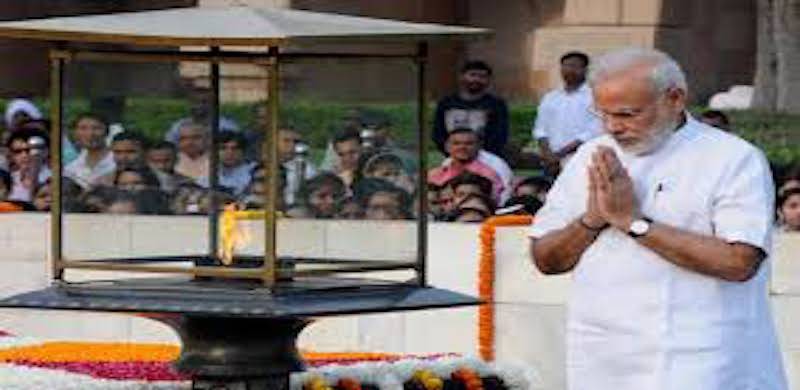
Narendra Modi made his intentions clear by choosing August 14 as Partition Horrors Remembrance Day in India, focusing solely on Hindus and Sikhs, excluding the many Muslim victims of the Partition. It was a cynical, vote-gaining, gimmick designed for the majority-Hindu electorate in the upcoming UP elections.
Indeed, Modi’s BJP has regularly used anti-Pakistan and anti-Muslim passions in UP to mobilise its Hindu base to ensure victory at the polls. Blaming MA Jinnah and the Muslim League alone for the Partition is a handy tool for the BJP.
Instead of diminishing the significance of an acutely tragic period in South Asian history, Modi should learn from the mass tragedy. Modi’s action could reopen old wounds and reignite ugly communal passions. It is time to put aside the blame game for the Partition and instead focus on its enduring ramifications for the region.
There is no simple way to explain the Partition. For 200 years, the British colonialists used the Hindu-Muslim schism to rule a large and diverse territory. The ‘divide and rule’ policy helped feed Hindu-Muslim distrust, diluting the anti-colonial struggle. Communal politics, myopic leadership, fear-mongering, and violence did not help. The idea that India belonged equally to all communities, and that democracy would prevent the dominance of Hindus or Muslims, did not last long — it led to the Partition in just a few decades.
Bouts of Hindu-Muslim riots were a part of life in the sub-continent. But the collective hate and savagery seen during the Partition caused an unprecedented scale of suffering. An estimated 2 million people — Hindus, Muslims, and Sikhs — perished in the mindless mob violence and reprisal killings. 14 million lost their ancestral homes.
Today, the Partition is generally viewed positively, with the British being deemed primarily responsible for the deaths and suffering. And yet, getting over the bitter shadow remains difficult even after 74 years.
As novelist Pankaj Mishra aptly put it: “The vicious politics of partition still seems to define India and Pakistan.”
In its lead up, the Partition’s proponents presented it as a political compromise between two communities, torn apart by religious communalism and seemingly irreconcilable differences. And yet, the scourge of religious communalism still blights the region with majoritarianism and religion giving impetus to xenophobia and toxic nationalism, pushing India and Pakistan towards each other’s throats in a suicidal competition.
The Partition meant the abandonment of pluralism and syncretic culture. It negated the values of peaceful coexistence, removing the bedrock of secure, progressive, and open societies. The sad outcome of promoting homogeneous and exclusive identities is painfully evident in South Asia.
Hindu and Muslim extremists, often at odds with each other, add to the misery and struggle of the people, particularly minorities, castes, and women. The Islamist experiment roars ahead in Pakistan, emboldened by the Taliban ‘victory’ in Afghanistan. And Hindutva supporters move forward with the creation of the Hindu Rashtra in India.
The Partition did not mean change for the millions of people in the region who continue to live in conditions of abject poverty and deprivation. Prospects for billions of dollars of bilateral trade between India and Pakistan remain a distant dream, with relations officially frozen. India (131) and Pakistan (154) fare poorly on the Human Development Index. Democracy and Gender Gap Index ratings for both countries are not much better. Yet, India and Pakistan are two of the 25 major military spenders in the world.
Learning the following lessons from the Partition is a necessity for both: revive the idea of South Asian harmony; keep religion separate from the state; combat identity-based politics; promote inclusive democracy; and abandon militarism to embrace peace.
This can best honour the memory of the millions of innocent victims of the Partition.
Indeed, Modi’s BJP has regularly used anti-Pakistan and anti-Muslim passions in UP to mobilise its Hindu base to ensure victory at the polls. Blaming MA Jinnah and the Muslim League alone for the Partition is a handy tool for the BJP.
Instead of diminishing the significance of an acutely tragic period in South Asian history, Modi should learn from the mass tragedy. Modi’s action could reopen old wounds and reignite ugly communal passions. It is time to put aside the blame game for the Partition and instead focus on its enduring ramifications for the region.
There is no simple way to explain the Partition. For 200 years, the British colonialists used the Hindu-Muslim schism to rule a large and diverse territory. The ‘divide and rule’ policy helped feed Hindu-Muslim distrust, diluting the anti-colonial struggle. Communal politics, myopic leadership, fear-mongering, and violence did not help. The idea that India belonged equally to all communities, and that democracy would prevent the dominance of Hindus or Muslims, did not last long — it led to the Partition in just a few decades.
Bouts of Hindu-Muslim riots were a part of life in the sub-continent. But the collective hate and savagery seen during the Partition caused an unprecedented scale of suffering. An estimated 2 million people — Hindus, Muslims, and Sikhs — perished in the mindless mob violence and reprisal killings. 14 million lost their ancestral homes.
Today, the Partition is generally viewed positively, with the British being deemed primarily responsible for the deaths and suffering. And yet, getting over the bitter shadow remains difficult even after 74 years.
As novelist Pankaj Mishra aptly put it: “The vicious politics of partition still seems to define India and Pakistan.”
In its lead up, the Partition’s proponents presented it as a political compromise between two communities, torn apart by religious communalism and seemingly irreconcilable differences. And yet, the scourge of religious communalism still blights the region with majoritarianism and religion giving impetus to xenophobia and toxic nationalism, pushing India and Pakistan towards each other’s throats in a suicidal competition.
Revive the idea of South Asian harmony; keep religion separate from the state; combat identity-based politics; promote inclusive democracy; and abandon militarism to embrace peace
The Partition meant the abandonment of pluralism and syncretic culture. It negated the values of peaceful coexistence, removing the bedrock of secure, progressive, and open societies. The sad outcome of promoting homogeneous and exclusive identities is painfully evident in South Asia.
Hindu and Muslim extremists, often at odds with each other, add to the misery and struggle of the people, particularly minorities, castes, and women. The Islamist experiment roars ahead in Pakistan, emboldened by the Taliban ‘victory’ in Afghanistan. And Hindutva supporters move forward with the creation of the Hindu Rashtra in India.
The Partition did not mean change for the millions of people in the region who continue to live in conditions of abject poverty and deprivation. Prospects for billions of dollars of bilateral trade between India and Pakistan remain a distant dream, with relations officially frozen. India (131) and Pakistan (154) fare poorly on the Human Development Index. Democracy and Gender Gap Index ratings for both countries are not much better. Yet, India and Pakistan are two of the 25 major military spenders in the world.
Learning the following lessons from the Partition is a necessity for both: revive the idea of South Asian harmony; keep religion separate from the state; combat identity-based politics; promote inclusive democracy; and abandon militarism to embrace peace.
This can best honour the memory of the millions of innocent victims of the Partition.

